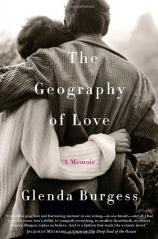Reading Group Guide
Discussion Questions
The Geography of Love

1. In her memoir’s prologue, Glenda Burgess recalls the child-friendly explanation her father gave for shooting stars: “Just a bit of chance and chaos, Sunshine. Atoms that dance.” How do these images apply to love? Did this description of the universe prove true in her life?
2. Discuss the memoir’s title. What does it mean to create a geography of love, mapping and describing its features? Where was love “located” for Glenda and Ken, both emotionally and on a map of the world? Which places and people have contributed most to your own geography of love?
3. What did Glenda’s parents teach her about being a spouse and a parent? How did her father’s downward spiral and her mother’s withdrawal affect her expectations of life?
4. What accounts for the instincts that helped Glenda know Ken was her soul mate? What is the best way for a couple to know whether they are compatible? Should age differences matter? Besides chronology, how can age be measured in other ways, such as maturity and wisdom, or whimsy and innocence?
5. In what ways were Glenda and Ken both wounded souls when they met each other? What enabled them to forge such a deep trust? Is intense love always tempered by the equally intense risk of losing someone who means so much?
6. How did your impressions of Ken evolve throughout Geography of Love? How did the author’s storytelling style create a vivid portrait of herself and of her beloved? Which scenes from your life would best create a portrait of you and those you love?
7. What turning points were marked when Beckah’s true killer was identified? How had the lives of Ken, Jordan, and Glenda been affected by the shadow of that violent night, and the fact that the crime went unsolved for so many years? What theories had you formed about the murder while reading the memoir’s initial chapters?
8. What was your first reaction to Ken’s illness and diagnosis, as well as that of Glenda’s mother, Louise? How did their experiences compare to that of other cancer patients you have known about? What did Ken’s and Louise’s stories reveal to you about the wrenching imprecision of treating this disease?
9. Did Glenda’s siblings have anything in common with Ken’s? What role did extended family play in creating stability as well as instability on both sides? What is the best way to navigate the tensions and the sometimes overwhelming generosity of extended family that often arise in the midst of a severe health crisis?
10. Were you surprised to hear Louise’s version of events as she recalled her marriage? How did her perception of her past and her life compare to Glenda’s images of growing up? Who “owns” the truth in the re-telling of a life?
11. Compounding the stress of Ken’s illness was the issue of health-care costs and insurance. As Glenda described the frantic tabulations regarding her husband’s coverage, what thoughts did you have about the economics of healthcare in America?
12. “I had learned to pray all wrong,” the author writes in “Ever You Fall.” “Real prayer, I understood, functioned in a unity of situation and awareness, a commune between the head and the heart.” How does her experience of spirituality shift throughout the book? What do she and Ken express about spirituality and its relationship to the physical world?
13. Louise and Ken chose opposing forms of treatment for their cancer, debating these approaches at a diner when they gathered after weeks of estrangement. Which treatment approach would you have favored? What are the limits and benefits of modern medicine?
14. As his illness progressed, Ken saw the ghost of his first wife, Diana. How did you interpret that scene? What are your beliefs about the process of departing from life, and the potential for interaction with those who have died? What did it mean to Ken to see his first love again after so many years? How had he processed the experience of loving three very different women, at three very different points in his life?
15. How do the memoir’s closing images echo the words of the poem that forms the book’s epigraph? What did Campbell McGrath’s words signify to you?
The Geography of Love
- Publication Date: August 5, 2008
- Genres: Nonfiction
- Hardcover: 320 pages
- Publisher: Crown Archetype
- ISBN-10: 0767928598
- ISBN-13: 9780767928595







